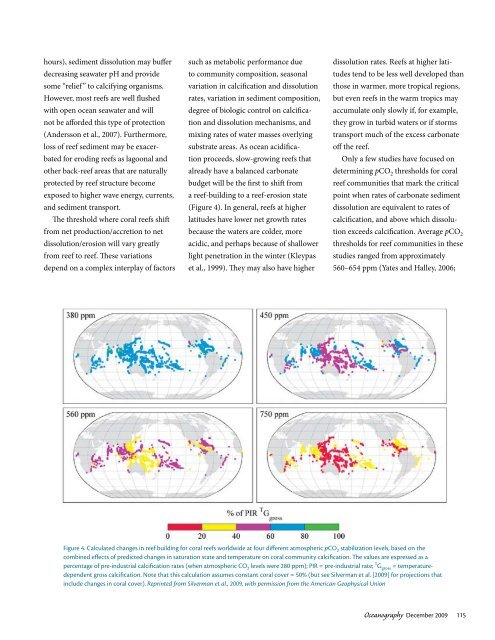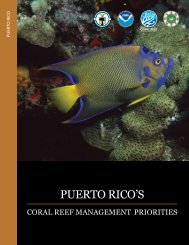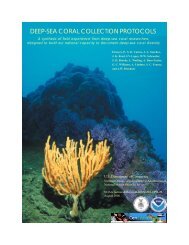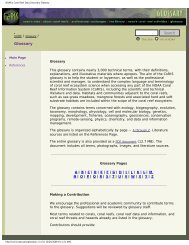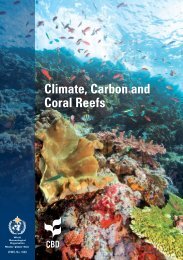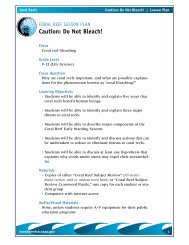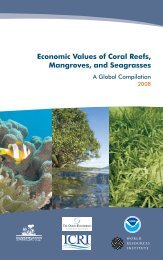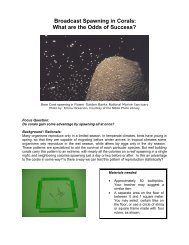coral reefs and Ocean acidification
coral reefs and Ocean acidification
coral reefs and Ocean acidification
Create successful ePaper yourself
Turn your PDF publications into a flip-book with our unique Google optimized e-Paper software.
hours), sediment dissolution may buffer<br />
decreasing seawater pH <strong>and</strong> provide<br />
some “relief ” to calcifying organisms.<br />
However, most <strong>reefs</strong> are well flushed<br />
with open ocean seawater <strong>and</strong> will<br />
not be afforded this type of protection<br />
(Andersson et al., 2007). Furthermore,<br />
loss of reef sediment may be exacerbated<br />
for eroding <strong>reefs</strong> as lagoonal <strong>and</strong><br />
other back-reef areas that are naturally<br />
protected by reef structure become<br />
exposed to higher wave energy, currents,<br />
<strong>and</strong> sediment transport.<br />
The threshold where <strong>coral</strong> <strong>reefs</strong> shift<br />
from net production/accretion to net<br />
dissolution/erosion will vary greatly<br />
from reef to reef. These variations<br />
depend on a complex interplay of factors<br />
such as metabolic performance due<br />
to community composition, seasonal<br />
variation in calcification <strong>and</strong> dissolution<br />
rates, variation in sediment composition,<br />
degree of biologic control on calcification<br />
<strong>and</strong> dissolution mechanisms, <strong>and</strong><br />
mixing rates of water masses overlying<br />
substrate areas. As ocean <strong>acidification</strong><br />
proceeds, slow-growing <strong>reefs</strong> that<br />
already have a balanced carbonate<br />
budget will be the first to shift from<br />
a reef-building to a reef-erosion state<br />
(Figure 4). In general, <strong>reefs</strong> at higher<br />
latitudes have lower net growth rates<br />
because the waters are colder, more<br />
acidic, <strong>and</strong> perhaps because of shallower<br />
light penetration in the winter (Kleypas<br />
et al., 1999). They may also have higher<br />
dissolution rates. Reefs at higher latitudes<br />
tend to be less well developed than<br />
those in warmer, more tropical regions,<br />
but even <strong>reefs</strong> in the warm tropics may<br />
accumulate only slowly if, for example,<br />
they grow in turbid waters or if storms<br />
transport much of the excess carbonate<br />
off the reef.<br />
Only a few studies have focused on<br />
determining pCO2 thresholds for <strong>coral</strong><br />
reef communities that mark the critical<br />
point when rates of carbonate sediment<br />
dissolution are equivalent to rates of<br />
calcification, <strong>and</strong> above which dissolution<br />
exceeds calcification. Average pCO2 thresholds for reef communities in these<br />
studies ranged from approximately<br />
560–654 ppm (Yates <strong>and</strong> Halley, 2006;<br />
Figure 4. calculated changes in reef building for <strong>coral</strong> <strong>reefs</strong> worldwide at four different atmospheric pcO 2 stabilization levels, based on the<br />
combined effects of predicted changes in saturation state <strong>and</strong> temperature on <strong>coral</strong> community calcification. The values are expressed as a<br />
percentage of pre-industrial calcification rates (when atmospheric cO 2 levels were 280 ppm); pir = pre-industrial rate; t g gross = temperaturedependent<br />
gross calcification. Note that this calculation assumes constant <strong>coral</strong> cover = 50% (but see Silverman et al. [2009] for projections that<br />
include changes in <strong>coral</strong> cover). Reprinted from Silverman et al., 2009, with permission from the American Geophysical Union<br />
<strong>Ocean</strong>ography december 2009 115


